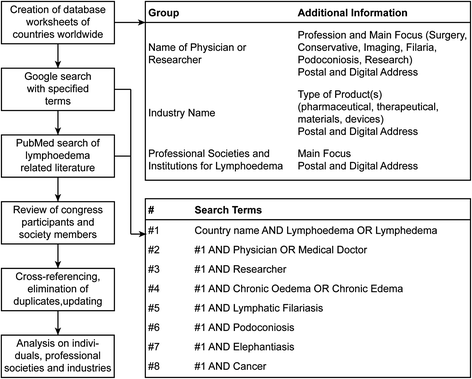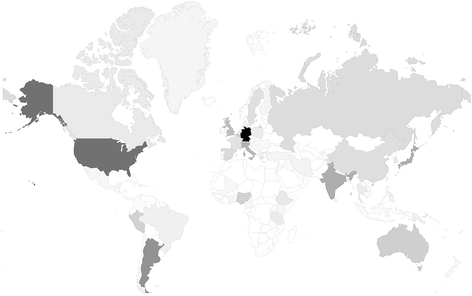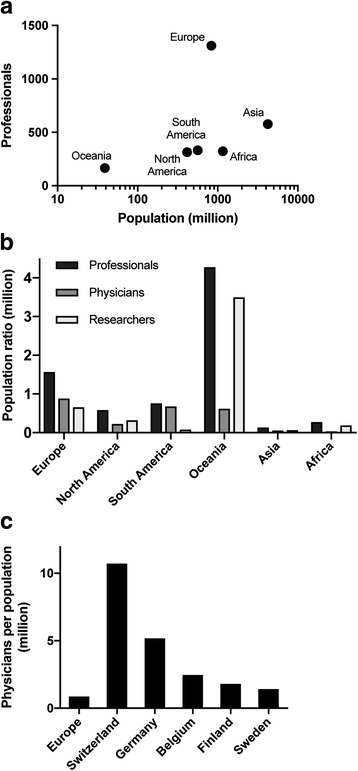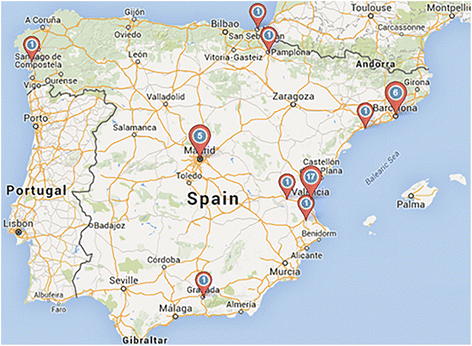Worldwide assessment of healthcare personnel dealing with lymphoedema
- PMID: 29663122
- PMCID: PMC5901432
- DOI: 10.1186/s13561-018-0194-6
Worldwide assessment of healthcare personnel dealing with lymphoedema
Abstract
Background: Lymphoedema is a pandemic with about 250 million people suffering from this condition worldwide. Lymphatic diseases have considerable public health significance, but yet few professionals are specialised in their management causing a substantial burden on health resources.
Aims and objectives: This study aims to give an overview of the approximate number of medical professionals, professional societies, institutions and companies dealing with lymphoedema in various countries. Concepts of improvement for current human resources are considered.
Methods: An online database analysis (Google search engine and PubMed) was carried out for each country of the world. Additionally, relevant congress participant lists as well as member lists of significant medical societies and reports of the World Health Organisation were analysed.
Results: Overall distribution of tertiary level professionals specialised in this field is heterogenous. A decrescent gradient of professionals can be seen between developed and developing countries and between urban and rural areas. Countries in general do not seem to have yet met the current demand for specialists at tertiary level in this field.
Conclusions: This study intends to draw attention to the current medical coverage gaps due to a low number of lymphoedema specialists at tertiary level. It wishes to start a discussion about structured reimbursement and certification of knowledge and skills that are essential incentives for experts to act as multiplicators and change the lack of care in the mid-term. Current fail prescriptions and evitable disability and sick certificates represent a high financial burden that could be reinvested in a correct management. Policy makers must focus in the two above mentioned essential measures. Medical training and the consequent development of the industry will then naturally take place, as it was the case for other professional groups in the past.
Keywords: Lymphatic diseases; Lymphoedema; Lymphology; Medical education; Medical healthcare resources.
Conflict of interest statement
Ethics approval and consent to participate
Not applicable.
Competing interests
We confirm that this manuscript describes original work and has neither been published elsewhere nor is under consideration by any other journal. All authors have approved the manuscript and agree with its submission to Health Economics Review. The study authors have no competing interests.
Publisher’s Note
Springer Nature remains neutral with regard to jurisdictional claims in published maps and institutional affiliations.
Figures




Similar articles
-
Lymphoedema management: an international intersect between developed and developing countries. Similarities, differences and challenges.Glob Public Health. 2012;7(2):107-23. doi: 10.1080/17441692.2010.549140. Epub 2011 May 24. Glob Public Health. 2012. PMID: 21360379
-
Japan as the front-runner of super-aged societies: Perspectives from medicine and medical care in Japan.Geriatr Gerontol Int. 2015 Jun;15(6):673-87. doi: 10.1111/ggi.12450. Epub 2015 Feb 5. Geriatr Gerontol Int. 2015. PMID: 25656311
-
Critical Care Network in the State of Qatar.Qatar Med J. 2019 Nov 7;2019(2):2. doi: 10.5339/qmj.2019.qccc.2. eCollection 2019. Qatar Med J. 2019. PMID: 31763205 Free PMC article.
-
Synergies between veterinarians and para-professionals in the public and private sectors: organisational and institutional relationships that facilitate the process of privatising animal health services in developing countries.Rev Sci Tech. 2004 Apr;23(1):115-35; discussion 391-401. doi: 10.20506/rst.23.1.1472. Rev Sci Tech. 2004. PMID: 15200091 Review.
-
Tuberculosis.In: Holmes KK, Bertozzi S, Bloom BR, Jha P, editors. Major Infectious Diseases. 3rd edition. Washington (DC): The International Bank for Reconstruction and Development / The World Bank; 2017 Nov 3. Chapter 11. In: Holmes KK, Bertozzi S, Bloom BR, Jha P, editors. Major Infectious Diseases. 3rd edition. Washington (DC): The International Bank for Reconstruction and Development / The World Bank; 2017 Nov 3. Chapter 11. PMID: 30212088 Free Books & Documents. Review.
Cited by
-
Improved lymphangiogenesis around vascularized lymph node flaps by periodic injection of hyaluronidase in a rodent model.Sci Rep. 2024 Oct 18;14(1):24430. doi: 10.1038/s41598-024-74414-4. Sci Rep. 2024. PMID: 39424818 Free PMC article.
-
Non-Linear Lymphatic Anatomy in Breast Cancer Patients Prior to Axillary Lymph Node Dissection: A Risk Factor For Lymphedema Development.J Mammary Gland Biol Neoplasia. 2023 Jul 22;28(1):20. doi: 10.1007/s10911-023-09545-x. J Mammary Gland Biol Neoplasia. 2023. PMID: 37480365 Free PMC article.
-
Current Understanding of Pathological Mechanisms of Lymphedema.Adv Wound Care (New Rochelle). 2022 Jul;11(7):361-373. doi: 10.1089/wound.2021.0041. Epub 2021 Nov 25. Adv Wound Care (New Rochelle). 2022. PMID: 34521256 Free PMC article. Review.
-
Improving care for cancer-related and other forms of lymphoedema in low- and middle-income countries: a qualitative study.BMC Health Serv Res. 2022 Apr 8;22(1):461. doi: 10.1186/s12913-022-07840-7. BMC Health Serv Res. 2022. PMID: 35395942 Free PMC article.
-
The Lymphatic System, Lymphoedema, and Medical Curricula-Survey of Australian Medical Graduates.Cancers (Basel). 2022 Dec 16;14(24):6219. doi: 10.3390/cancers14246219. Cancers (Basel). 2022. PMID: 36551705 Free PMC article.
References
-
- Földi M, Földi E. Földi’s textbook of lymphology for physicians and Lymphoedema therapists. 3rd rev. München: Urban & Fischer; 2012.
Grants and funding
LinkOut - more resources
Full Text Sources
Other Literature Sources
Miscellaneous

